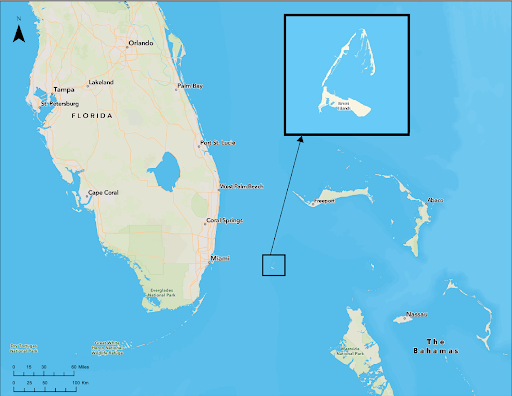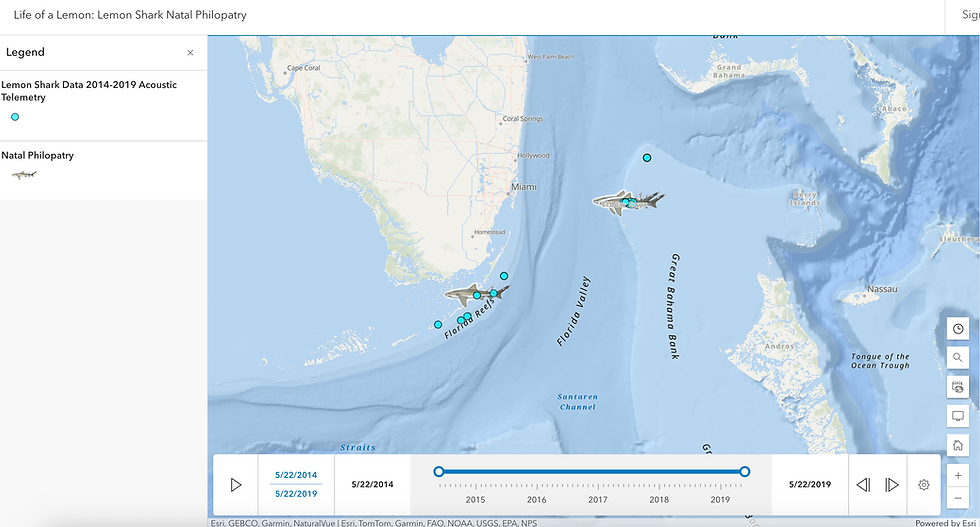Life of a Lemon by Emma Beaver
- Bimini Shark Stalkers

- Jul 18
- 3 min read
Many of the Shark Lab’s studies have focused on the lemon shark (Negaprion brevirostris), an elasmobranch that is closely linked to the environment in Bimini. Bimini hosts a range of ecosystems, with the mangrove habitats being one of the most crucial for the lifecycle of lemon sharks. These tidal forests serve as nursery grounds for juvenile lemons, offering protection and resources during their initial life stages.

Because of the lemon shark’s special life cycle, there have been groundbreaking research methods and outcomes on their home range, social behavior, lifecycle, genetics, and more. These ongoing efforts contributed to the creation of the PIT Project. In 1995, the Lab began tagging the juvenile lemons born in the mangroves surrounding Bimini with small microchips, called Passive Integrated Transponder (PIT) tags, a similar technology to a microchip used for pets. Over the years, this study produced publications and further research, creating important ideas like the “lemon shark family tree” and the study of natal philopatry.
Natal philopatry is a life strategy where animals return to their place of birth to then reproduce. For lemon sharks in Bimini, this means they are traveling to the same region of mangroves where they were born. Lemon sharks exhibit viviparity (Abel & Grubbs), meaning they give live birth, but there is little to no parental relationship for these sharks, leaving the juvenile lemons on their own after birth. Lemon shark natal philopatry research in Bimini is a novel understanding of the life cycle and reproduction of the species. With little to no parental care, the newborn pups live in the mangroves for up to seven years, growing in size and gathering foraging skills, while still under the protection of the mangrove habitats.

The two nursery and research grounds in Bimini are referred to as North Sound and Sharkland. The map below displays these two locations.

Despite having a small home range, as juvenile lemon sharks mature, they eventually venture beyond the mangroves, likely traveling within the Bahamas and to coastal regions of the United States. With the help of other technology like acoustic telemetry, the lab is able to retrieve data on movement and habitat use. Acoustic telemetry studies utilize receivers in various locations that correspond to acoustic tags that have been deployed in sharks.
In the case of natal philopatry, these receivers help to show mature lemon sharks returning to the mangroves. The animated map below displays the philopatric movement of an adult female lemon shark exiting and reentering Bimini to drop her pups. By inserting an acoustic tag in this shark during prior research, our receivers pick up her movement when she returns to Bimini.
While she did not return every other year as expected, the data suggests she consistently revisits the mangroves she was born in to reproduce.

In order to access the map, click on the link below. Press the play button to watch the animations develop. The blue dots represent places she has been throughout this five-year period, and the shark icons throughout time represent this female lemon shark pinging in Bimini, and then in Florida, and back to Bimini again. While she did not return exactly every other year, it is still assumed she is returning to the mangroves in Bimini to pup. She is seen in Bimini in 2014 and 2019, see the link below for more information.
Interactive Map: Lemon Shark Natal Philopatry

With coastal development and habitat destruction, the habitats that these lemon sharks rely on are at risk. Once they venture out beyond the mangroves and beyond the Bahamas sanctuary, lemons, along with other species, are susceptible to exterior factors such as fishing and bycatch. Protecting mangroves in Bimini means protecting the species that reside within. The ongoing efforts of the Bimini Shark Lab in research, education, and conservation serve to protect these species while deepening the understanding of their survival.
Acknowledgements
Daniel C Abel. and Dean Grubbs, Shark Biology and Conservation: Essentials for Educators, Students, and Enthusiasts
Mapping Assistance from Ethan Vlahov, GIS Analyst



